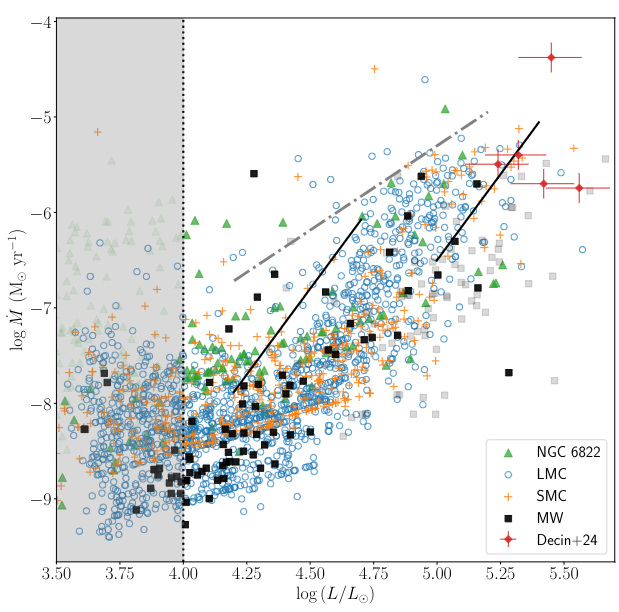K. Antoniadis, E. Zapartas, A. Z. Bonanos, G. Maravelias, S. Vlassis, G. Munoz-Sanchez, C. Nally, M. Meixner, O. C. Jones, L. Lenkic, P. J. Kavanagh
Red supergiants (RSGs) are cool and evolved massive stars exhibiting enhanced mass loss compared to their main sequence phase, affecting their evolution and fate. However, the theory of the wind-driving mechanism is not well-established and the metallicity dependence has not been determined. We aim to uniformly measure the mass-loss rates of large samples of RSGs in different galaxies with −0.7≲[Z]≲0 to investigate whether there is a potential correlation with metallicity. We collected photometry from the ultraviolet to the mid-infrared for all our RSG candidates to construct their spectral energy distribution (SED). Our final sample includes 893 RSG candidates in the Small Magellanic Cloud (SMC), 396 in NGC 6822, 527 in the Milky Way, 1425 in M31, and 1854 in M33. Each SED was modelled using the radiative transfer code DUSTY under the same assumptions to derive the mass-loss rate. The mass-loss rates range from approximately 10−9 M⊙ yr−1 to 10−5 M⊙ yr−1 with an average value of 1.5×10−7 M⊙ yr−1. We provided a new mass-loss rate relation as a function of luminosity and effective temperature for both the SMC and Milky Way and compared our mass-loss rates with those derived in the Large Magellanic Cloud (LMC). The turning point in the mass-loss rate vs. luminosity relation differs by around 0.2 dex between the LMC and SMC. The mass-loss rates of the Galactic RSGs at log(L/L⊙)<4.5 were systematically lower than those determined in the other galaxies, possibly due to uncertainties in the interstellar extinction. We found 30-40% of the RSGs not to have any dust. The results for M31 and M33 are inconclusive because of source blending at distances above 0.5 Mpc given the resolution of Spitzer. Overall, we found similar mass-loss rates among the galaxies, indicating no strong correlation with metallicity.

arXiv: 2503.05876, submitted to A&A.
